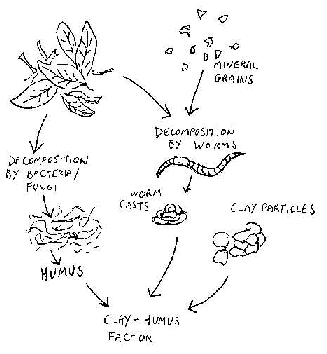Humus
|
|
- For the food, see Hummus.
- For the band, see Humus (band).
Humus is a complex organic substance resulting from the breakdown of plant material in a process called humification. This process can occur naturally in soil, or in the production of compost. Humus is extremely important to the fertility of soils in both a physical and chemical sense (see below). Physically it helps the soil retain moisture and encourages the formation of good soil structure. Chemically, it has many active sites which bind to ions of plant nutrients, making them more available. Humus is often described as the 'life-force' of the soil. Yet it is difficult to define humus in precise terms; it is a highly complex substance, the full nature of which is still not fully understood. Physically humus can be differentiated from organic matter in that the latter is rough looking material, with coarse plant remains still visible, whilst once fully humified it become more uniform in appearance (a dark, spongy, jelly-like substance) and amorphous in structure. That is, it has no determinate shape, structure or character.
Plant remains (including those that have passed through an animal and are excreted as manure) contain organic compounds: sugars, starches, proteins, carbohydrates, lignins, waxes, resins and organic acids. The process of organic matter decay in the soil begins with the decomposition of sugars and starches from carbohydrates which break down easily as saprophytes initially invade the dead plant, whilst the remaining cellulose breaks down more slowly. Proteins decompose into amino acids at a rate depending on carbon to nitrogen ratios. Organic acids break down rapidly, while fats, waxes, resins and lignins remain relatively unchanged for longer periods of time. The humus that is the end product of this process is thus a mixture of compounds and complex life chemicals of plant, animal or microbial origin which has many functions and benefits in the soil as outlined below;
- The mineralisation process that converts raw organic matter to the relatively stable substance that is humus feeds the soil population of micro-organisms and other creatures thus maintaining high and healthy levels of soil life.
- Effective and stable humus (see below) are further sources of nutrients to microbes, the former providing a readily available supply whilst the latter acts as a more long term storage reservoir.
- Humification of dead plant material causes complex organic compounds to break down into simpler forms which are then made available to growing plants for uptake through their root systems.
- Humus is a colloidal substance, and increases the soil's cation exchange capacity, hence its ability to store nutrients on clay particles, thus whilst these nutrient cations are accessible to plants they are held in the soil safe from leaching away by rain or irrigation.
- Humus can hold the equivalent of 80-90% of its weight in moisture, thus increases the soil's capacity to withstand drought conditions.
- The biochemical structure of humus enables it to moderate- or buffer- excessive acid or alkaline soil conditions.
- During the Humification process microbes secrete sticky gums- these contribute to the crumb structure of the soil by holding particles together, allowing greater aeration of the soil. Toxic substances such as heavy metals, as well as excess nutrients, can be chelated (that is, bound to the complex organic molecules of humus) and prevented from entering the wider ecosystem.
- The dark colour of humus (usually black or dark brown) helps to warm up cold soils in the spring.
Humification of leaf litter and formation of clay-humus complexes
Humus which is readily capable of further decomposition is referred to as effective or active humus. It is principally derived from sugars, starches and proteins and consists of simple organic (fulvic) acids. It is an excellent source of plant nutrients, but of little value regarding long term soil structure and tilth. Stable (or passive) humus consisting of humic acids, or humins, on the other hand, are so highly insoluble (or tightly bound
to clay particles that they cannot be penetrated by microbes) that they are greatly resistant to further decomposition. Thus they add few readily available nutrients to the soil, but play an essential part in providing its physical structure. Some very stable humus complexes have survived for thousands of years. Stable humus tends to originate from woodier plant materials, eg, cellulose and lignins.
Humus should not be thought of as 'dead'- rather it is the 'raw matter' of life- the transition stage between one life form and another. It is a part of a constant process of change and organic cycling, thus must be constantly replenished- for when we are removing prunings and crops for the kitchen we are depriving nature's cycle of potential humus. This is why we need to substitute compost and other sources of organic matter to maintain the fertility of our productive land.bg:Хумус cs:Humus da:Humus de:Humus fr:Humus he:הומוס nl:Humus pl:Próchnica

